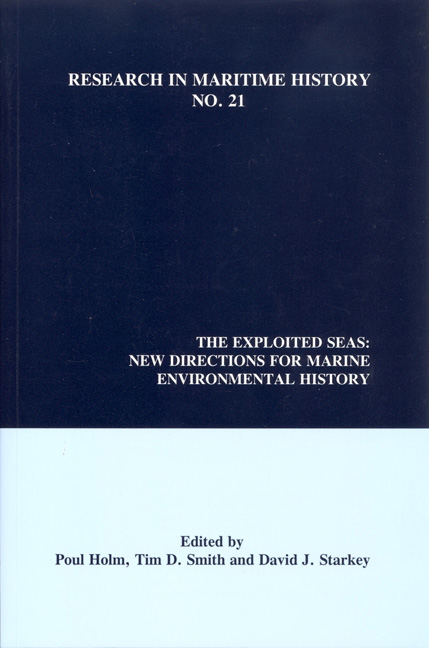Book contents
- Frontmatter
- Contents
- About the Editors
- Contributors
- “Introduction”
- Contributions
- “The Newfoundland Fisheries, c. 1500-1900: A British Perspective”
- “Testing Ecological Models: The Influence of Catch Rates on Settlement of Fishermen in Newfoundland, 1710-1833”
- “Nineteenth-Century Expansion of the Newfoundland Fishery for Atlantic Cod: An Exploration of Underlying Causes”
- “Status and Potential of Historical and Ecological Studies on Russian Fisheries in the White and Barents Seas: The Case of the Atlantic Salmon (Salmo Salar)”
- “The Danish Fisheries, c. 1450-1800: Medieval and Early Modern Sources and Their Potential for Marine Environmental History”
- “Historical Approaches to the Northern California Current Ecosystem”
- “Potential for Historical-Ecological Studies of Latin American Fisheries”
- “The South African Fisheries: A Preliminary Survey of Historical Sources”
- “The Potential for Historical Studies of Fisheries in Australia and New Zealand”
- “Examining Cetacean Ecology Using Historical Fishery Data”
“The Danish Fisheries, c. 1450-1800: Medieval and Early Modern Sources and Their Potential for Marine Environmental History”
from Contributions
- Frontmatter
- Contents
- About the Editors
- Contributors
- “Introduction”
- Contributions
- “The Newfoundland Fisheries, c. 1500-1900: A British Perspective”
- “Testing Ecological Models: The Influence of Catch Rates on Settlement of Fishermen in Newfoundland, 1710-1833”
- “Nineteenth-Century Expansion of the Newfoundland Fishery for Atlantic Cod: An Exploration of Underlying Causes”
- “Status and Potential of Historical and Ecological Studies on Russian Fisheries in the White and Barents Seas: The Case of the Atlantic Salmon (Salmo Salar)”
- “The Danish Fisheries, c. 1450-1800: Medieval and Early Modern Sources and Their Potential for Marine Environmental History”
- “Historical Approaches to the Northern California Current Ecosystem”
- “Potential for Historical-Ecological Studies of Latin American Fisheries”
- “The South African Fisheries: A Preliminary Survey of Historical Sources”
- “The Potential for Historical Studies of Fisheries in Australia and New Zealand”
- “Examining Cetacean Ecology Using Historical Fishery Data”
Summary
Abstract
Primary source materials held in Danish archives are of great value for environmental historians seeking evidence from which to construct long time series relating to the inshore fisheries of regions bordering the North and Baltic seas. This paper focuses on documentary sources pertaining to these fisheries in the sixteenth and seventeenth centuries, but attention is also afforded to ways of extending the time series. Estate records reveal the diversity of Denmark's fishing interests when the catching effort reached a relative peak in the late Middle Ages (c. 1450-1590). At this time, haddock, rather than cod, formed the bulk of the North Sea catch, demonstrating that this species lived much farther south in the North Sea than it does today and suggesting that it was more abundant than it is today. The herring catch records reveal decadal to centennial shifts in abundance between the Limfjord and Bohuslen, possibly related to climate forcing. The historical evidence also reveals that Baltic cod seems to be related to a periodical pattern with high abundance in the seventeenth and late twentieth century interspaced with a period of low abundance. The paper examines why the Danish fisheries declined rapidly in the seventeenth century, with natural causes - climatic change, salinity changes and species competition - set against human social and economic factors, such as changing dietary preferences and the competitive forces of the market.
Danish Historical Sources
Before 1658, the Kingdom of Denmark comprised the provinces of present-day southern Sweden (namely Scania, Halland and Blekinge), as well as its current territories of Jutland, Funen, Sealand and Bornholm (see figure 1). The archival sources generated in these provinces were therefore assembled according to Danish administrative practice. Moreover, Norway, which is not covered in this paper, was under Danish control until 1814, and accordingly its records were devised in line with Danish administrative practice. There is thus much uniformity in the information that relates to the highly saline-to-brackish waters bordering the North Sea, and the data concerning the Baltic, including the Skagerrak and Kattegat, and the brackish Limfjord. While a broad range of sources yields information on Danish medieval and early modern fisheries, the regional estate accounts of fiscal revenue are of special importance for the construction of long time series.
- Type
- Chapter
- Information
- The Exploited SeasNew Directions for Marine Environmental History, pp. 97 - 122Publisher: Liverpool University PressPrint publication year: 2001



